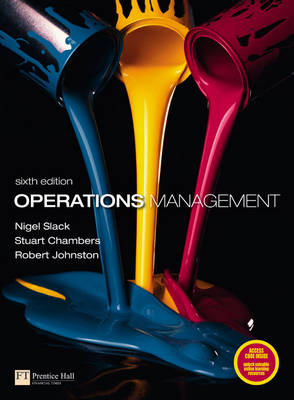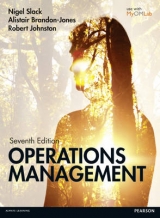
Operations Management
Prentice Hall (Verlag)
978-0-273-73046-0 (ISBN)
- Titel erscheint in neuer Auflage
- Artikel merken
A long-time market leader in this discipline, Slack has set the standards in Operations Management which other textbooks seek to emulate. Expert authorship, an engaging writing style, and an interesting collection of cases combine to communicate the importance of managing operations and processes within a successful organisation.
Operations Management provides a strategic perspective, whilst also examining the practical issues which organisations face on a day to day basis. It uses over 120 examples from all over the world, reflecting the balance of economic activity between service (c.75%) and manufacturing (c.25%) operations.
Part One INTRODUCTION
1. Operations management
Introduction
What is operations management?
Operations management is important in all types of organization
The input transformation output process
The process hierarchy
Operations processes have different characteristics
The activities of operations management
Summary answers to key questions~
Case study: Design house partnerships at Concept Design Services
Problems and applications
Selected further reading
Useful web sites
2. Operations performance
Introduction
Operations performance is vital for any organization
The quality objective
The speed objective
The dependability objective
The flexibility objective
The cost objective
Trade-offs between performance objectives
Summary answers to key questions
Case study: Operations objectives at the Penang Mutiara
Problems and applications
Selected further reading
Useful web sites
3. Operations strategy
Introduction
What is strategy and what is operations strategy?
The 'top-down' and 'bottom-up' perspectives
The market requirements and operations resources perspectives
The process of operations strategy
Summary answers to key questions
Case study: Long Ridge Gliding Club
Problems and applications
Selected further reading
Useful web sites
Part Two DESIGN
4. Process design
Introduction
What is process design?
What effects should process design have?
Process types the volume variety effect on process design
Detailed process design
Summary answers to key questions
Case study: The Central Evaluation Unit
Problems and applications
Selected further reading
Useful web sites
5. The design of products and services
Introduction
Why is good design so important?
The benefits of interactive design
Summary answers to key questions
Case study: Chatsworth the adventure playground decision
Problems and applications
Selected further reading
Useful web sites
6. Supply network design
Introduction
The supply network perspective
Configuring the supply network
The location of capacity
Long-term capacity management
Summary answers to key questions
Case study: Disneyland Resort Paris (abridged)
Problems and applications
Selected further reading
Useful web sites
Supplement to Chapter 6 Forecasting
Introduction
Forecasting knowing the options
In essence forecasting is simple
Approaches to forecasting
The performance of forecasting models
Notes on chapter
Selected further reading
7. Layout and flow
Introduction
What is layout?
The basic layout types
What type of layout should an operation choose?
Detailed design of the layout
Summary answers to key questions
Case study: Weldon Hand Tools
Problems and applications
Selected further reading
Useful web sites
8. Process technology
Introduction
What is process technology?
Understanding process technologies
Evaluating process technologies
Implementing process technologies
Summary answers to key questions
Case study: Rochem Ltd
Problems and applications
Selected further reading
Useful web sites
9. People, jobs and organization
Introduction
People in operations
Human resource strategy
Job design
Summary answers to key questions
Case study: Service Adhesives tries again
Problems and applications
Selected further reading
Useful web sites
Supplement to Chapter 9 Work study
Introduction
Method study in job design
Work measurement in job design
Part Three PLANNING AND CONTROL
10. The nature of planning and control
Introduction
What is planning and control?
Supply and demand affect planning and control
Planning and control activities
Summary answers to key questions
Case study: Air traffic control a world-class juggling act
Problems and applications
Selected further reading
Useful web sites
11. Capacity planning and control
Introduction
What is capacity management?
Measuring demand and capacity
The alternative capacity plans
Choosing a capacity planning and control approach
Capacity planning as a queuing problem
Summary answers to key questions
Case study: Holly Farm
Problems and applications
Selected further reading
Useful web sites
Supplement to Chapter 11 Analytical queuing models
Introduction
Notation
Variability
Incorporating Little's law
Types of queuing system
12. Inventory planning and control
Introduction
What is inventory?
Why is inventory necessary?
Some disadvantages of holding inventory
The volume decision how much to hold
The timing decision when to place an order
Inventory analysis and control systems
Summary answers to key questions
Case study: Trans-European Plastics
Problems and applications
Selected further reading
Useful web sites
13. Supply chain planning and control
Introduction
What is supply chain management?
The activities of supply chain management
Types of relationships in supply chains
Supply chain behaviour
Supply chain improvement
Summary answers to key questions
Case study: Supplying fast fashion
Problems and applications
Selected further reading
Useful web sites
14. Enterprise resource planning (ERP)
Introduction
What is ERP?
How did ERP develop?
Implementation of ERP systems
Summary answers to key questions
Case study: Psycho Sports Ltd
Problems and applications
Selected further reading
Useful web sites
Supplement to Chapter 14 Materials requirements planning (MRP)
Introduction
Master production schedule
The bill of materials (BOM)
Inventory records
The MRP netting process
MRP capacity checks
Summary
15. Lean synchronization
Introduction
What is lean synchronization?
Eliminate waste
Lean synchronization applied throughout the supply network
Lean synchronization and other approaches
Summary answers to key questions
Case study: Boys and Boden (B&B)
Problems and applications
Selected further reading
Useful web sites
16. Project planning and control
Introduction
What is a project?
Successful project management
The project planning and control process
Network planning
Summary answers to key questions
Case study: United Photonics Malaysia Sdn Bhd
Problems and applications
Selected further reading
Useful web sites
17. Quality management
Introduction
What is quality and why is it so important?
Diagnosing quality problems
Conformance to specification
Total quality management (TQM)
Summary answers to key questions
Case study: Turnround at the Preston plant
Problems and applications
Selected further reading
Useful web sites
Supplement to Chapter 17 Statistical process control (rts for attributes
Control chart for variables
Process control, learning and knowledge
Acceptance sampling
Sampling plans
Summary of supplement
Selected further reading
Useful web sites
Part Four IMPROVEMENT
18. Operations improvement
Introduction
Why improvement is so important
Elements of improvement
Approaches to improvement
Improvement techniques
Summary answers to key questions
Case study: Geneva Construction and Risk
Problems and applications
Selected further reading
Useful web sites
19. Risk management
Introduction
What is risk management?
Assess the potential causes of and risks from failure
Preventing failure occurring
Mitigating the effects of failure
Recovering from the effects of failure
Summary answers to key questions
Case study: The Chernobyl failure
Problems and applications
Selected further reading
Useful web sites
20. Organizing for improvement
Introduction
Why the improvement effort needs organizing
Linking improvements to strategy
Information for improvement
Improvement priorities what to start on?
Improvement culture
Building an improvement capability
Improvement as learning
Implementing improvement
Improvement or quality awards
Summary answers to key questions
Case study: Re-inventing Singapore's libraries
Problems and applications
Selected further reading
Useful web sites
Part Five CORPORATE SOCIAL RESPONSIBILITY
21. Operations and corporate social responsibility (CSR)
Introduction
What is corporate social responsibility?
How does the wider view of corporate social responsibility influence operations
management?
How can operations managers analyse CSR issues?
Summary answers to key questions
Case study: CSR as it is presented
Problems and applications
Selected further reading
Useful web sites
| Erscheint lt. Verlag | 16.12.2009 |
|---|---|
| Sprache | englisch |
| Maße | 265 x 196 mm |
| Gewicht | 1286 g |
| Themenwelt | Wirtschaft ► Betriebswirtschaft / Management ► Logistik / Produktion |
| ISBN-10 | 0-273-73046-0 / 0273730460 |
| ISBN-13 | 978-0-273-73046-0 / 9780273730460 |
| Zustand | Neuware |
| Haben Sie eine Frage zum Produkt? |
aus dem Bereich



